Armenian Army
| Army of the Republic of Armenia Հայաստանի Հանրապետության բանակ | |
|---|---|
| Active | January 28, 1992 – Present |
| Country | Republic of Armenia |
| Type | Army |
| Role | Ground warfare |
| Size |
45,850 (including 19,950 professional and 25,900 conscripts)[1] (2013 cencus) |
| Engagements |
Nagorno-Karabakh War Peacekeeping roles in Kosovo, Afghanistan and Lebanon |
| Commanders | |
| Notable commanders |
-Vazgen Sargsyan -Arkady Ter-Tatevosyan |
The Armenian Army (Armenian: Հայկական բանակ) is the largest branch of the Armed Forces of Armenia and consists of the ground forces responsible for the country's land-based operations. It was established in conjunction with the other components of Armenia's military on January 28, 1992, several months after the republic declared its independence from the Soviet Union.[2] The army's first head was the former deputy commander-in-chief of the main staff of the Soviet Ground Forces, Norat Ter-Grigoryants.[3]
Since the end of the Nagorno-Karabakh War, Armenia has committed many elements of the army to help bolster the defense and defend the unrecognized Republic of Nagorno-Karabakh from a possible renewal of hostilities with neighboring Azerbaijan. Jane's World Armies reports that both conscripts and officers from Armenia are routinely sent for duty to Karabakh, often posted to the frontline between Karabakh Armenian and Azerbaijani forces.[4]
History
The Armenian army's history is described to have gone through three stages of development.[5] It entered the first stage in February 1988, from the beginning of the Nagorno-Karabakh conflict, when Armenian militias were formed to combat Azerbaijani units in Nagorno-Karabakh. The second phase of the development of the army began in 1992, several months after Armenia declared its independence from the Soviet Union. Ter-Grigoryants and civilian officials in the Armenian Ministry of Defense, including Vazgen Manukyan and Vazgen Sargsyan, sought to establish a "small, well-balanced, combat-ready defense force."[6] The third phase began after the end of the war and continues to today.
Most of the army's staff officers were members of the former Soviet military. An estimated 5,000 Armenians were serving as high-level officers in the military at the time of the collapse of the Soviet Union.[7] Almost immediately after its independence, Armenia was embroiled in the Nagorno-Karabakh War with neighboring Azerbaijan. Intending to establish a force of 30,000 men, the army's standing force increased to 50,000 by early 1994. During the war, the military remained on high alert and bolstered defenses in the region of Zangezur, opposite the Azerbaijani exclave of Nakhichevan. Purported artillery bombardment in May 1992 from the region led to skirmishes between the two sides, including the Armenian army's incursion into several villages into Nakhichevaan.
Since 1994, the army has taken an active role in ensuring the defense of the Nagorno Karabakh Republic in conjunction with the Nagorno-Karabakh Defense Army.[8]
International deployments

The Armenian army has collaborated in several international missions with the West. On February 12, 2004, Armenia deployed a platoon-sized unit (three squads) to Kosovo as a part of the Greek peacekeeping battalion. The unit, known as the Peacekeeping Forces of Armenia, is headquartered in Camp "REGAS FEREOS" as a part of the Multi-National Task Force East and is tasked with maintaining vehicle check points, providing security for the base but also serves as a quick reaction force and crowd and riot control.[9] In 2008, the KFOR unit was expanded, adding a second platoon plus company staff (bringing Armenia's contingent to about 85 personnel).[10]
In the autumn of 2004, the Armenian government approved the dispatch of a 46-man contingent from the army consisting of sappers, engineers and doctors under Polish command as part of the Multinational Force in Iraq. On November 10, 2006, Senior Lieutenant Georgy Nalbandyan was injured in a mine explosion in Iraq but survived after being transported for surgery to a hospital in Landstuhl, Germany, near Ramstein Air Base.[11] On October 6, 2008, due to improving security conditions, the contingent's tour of duty came to an end.[12]
In July 2009, the Defense Minister of Armenia, Seyran Ohanyan, announced that Armenia would send a force to participate with the International Security Assistance Force (ISAF) in the War in Afghanistan by the end of the year. He did not mention how large the force would be but did note that it probably would include munitions experts and communications officers. A MOD spokesmen also stated that the force would include medical specialists and translators as well. Ohanyan added that Armenian officers who served in the Soviet military during the Soviet War in Afghanistan also expressed the desire to return there as members of the new force.[13] In November 2009, a NATO official affirmed that an Armenian contingent numbering 30 troops will join the ISAF sometime in early 2010.[14] That number was revised to 40 in early December, when the Armenian parliament overwhelmingly voted in approval of the contingent's deployment. The servicemen arrived in Afghanistan in February 2010, where, under German command, they are tasked to defend the regional airport in Kunduz.[15] There are currently 126 servicemen in Afghanistan.[16]
In conjunction with its strategic allies, Armenia has sent over 1,500 officers to be trained in Greece and Russia.[5] The Armenian Ministry of Defense also established in 2004 a joint partnership with the Kansas National Guard in order to exchange knowledge and facilitate cooperation in national security and civilian affairs. It also signed a military cooperation plan with Lebanon on November 27, 2015.[17]
Organization
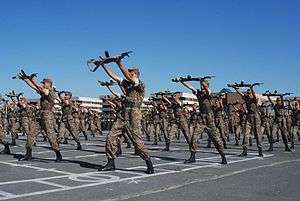
General Staff
- Colonel-General Seyran Ohanyan - Defense Minister
- Colonel-General Mikael Harutyunyan - Chief Military Inspector and Presidential Advisor
- Colonel-General Gurgen Daribaltayan — Deputy head of Chief of Staff and special military adviser to current president, Serzh Sargsyan
- Colonel-General Harut Kassabyan - Commander of Capital Guard
- Lieutenant-General Aghik Myurzabekyan
- Lieutenant-General Arthur Aghabekyan
- Lieutenant-General Yuri Khachaturov
- Lieutenant-General Gurgen Melkonyan
- Lieutenant-General Roland Kereshyan
Academies
- Monte Melkonian Military Academy
- Vazgen Sargsyan Military Academy
Field Forces

- 1st Army Corps (HQ Goris):[4] one independent tank battalion, one independent reconnaissance battalion, two motor rifle regiments.[18]
- 2nd Army Corps (HQ Khachaghbyur): one independent tank battalion, one independent reconnaissance battalion, one independent rifle regiment, two independent motor rifle regiments, one independent artillery battalion.
- 3rd Army Corps (HQ Vanadzor): one independent rifle regiment, one independent artillery battalion, one independent tank battalion, one independent reconnaissance battalion, one independent rocket artillery battalion, four independent motor rifle regiments, one maintenance battalion, one signals battalion.
- 4th Army Corps (HQ Yeghegnadzor): four independent motor rifle regiments, an independent self-propelled artillery battalion, one signals battalion.
- 5th Army Corps (HQ Nubarashen in Yerevan): two fortified regions, one independent motor rifle regiment, one independent rifle regiment.
- Army-level Troops:[18] one air and air defence joint command (Jane's World Armies mentions an Army Air and Air Defence at Chobankara under Colonel Ararat Hambarian), one training motor rifle brigade, one special forces regiment (Jane's World Armies mentions a regiment at Nubarashen under Colonel Artur Simonian), one artillery brigade, one self-propelled artillery regiment, one anti-tank regiment, one engineer regiment with demining centre, one surface-to-air missile brigade, two surface-to-air missile regiments, one radiotechnical (radar) regiment.[19]
Special Forces
The Armenian military's special forces include a standard army special forces regiment, and 3+ reconnaissance battalions. (Excluding Nagorno-Karabakh Defense Army Special Forces and National Defense forces, both of which are heavily integrated into the Armenian Armed Forces.) The operational history surrounding all the aforementioned groups are not known, the operation's that are known and are outside of standard duties such as intelligence gathering include:
- Unknown number of cross-border raids [20]
- The securing of Armenian pilot's remains and helicopter parts after the shoot down of a Nagorno-Karabakh helicopter [21]
The special forces of both republics are allowed fast-attack vehicles to conduct some operations and exercises.
Equipment
Small arms
| Weapon | Caliber | Origin | Notes |
|---|---|---|---|
| Pistols | |||
| MP-443 Grach | 9x19 mm | Used by special forces and police | |
| Makarov PM | 9x18 mm | Service Pistol | |
| Assault Rifles, Battle Rifles and Carbines | |||
| AK-74 | 5.45×39 mm | Standard Service Rifle AKS-74 variant included. | |
| AK-74M | 5.45×39 mm | Used by special forces | |
| AK-105 | 5.45×39 mm | Used mainly by border guards and special forces | |
| AKM | 7.62×39 mm | Used by all branches. AKMS variant included. | |
| AK-47 | 7.62×39 mm | Used by all branches | |
| AKS-74U | 5.45×39 mm | Used by special forces, police, and vehicle crews. Usually used for urban/close quarter combat and counter-terrorism operations | |
| VSS Vintorez | 9×39mm | Used by special forces | |
| AS Val | 9×39mm | Used by special forces | |
| K-3 | 5.45×39 mm | Used mainly by the special forces | |
| Sniper Rifles | |||
| Accuracy International AX-338[22] | .338 Lapua Magnum | Used by snipers and Special Forces. | |
| Dragunov SVD | 7.62×54 mm | Main service sniper rifle. New units to be delivered as part of the 2015 Armenian-Russian arms deal. | |
| Truvelo CMS[23] | 12.7x99 mm | ||
| K-11 | 5.45×39 mm | Used by the Armenian armed forces | |
| PGM 338 | .338 Lapua Magnum | Used by snipers and the Special Forces | |
| Sv-98 | .338 Lapua Magnum | Used by snipers and the Special Forces | |
| Zastava M93 Black Arrow | 12.7×108 mm | An anti-materiel sniper rifle is used by snipers and Special Forces | |
| Machine Guns | |||
| RPK-74 | 5.45×39 mm | ||
| PK machine gun | 7.62×54 mm | ||
| DShK | 12.7×108 mm | ||
| NSV machine gun | 12.7×108 mm | ||
| Kord machine gun[24] | 12.7×108 mm | ||
| Grenade Launchers | |||
| AGS-17 | 30 x 29 grenade | ||
| AGS-30 | 30 x 29 grenade | ||
| Anti-tank Systems | |||
| RPG-7 | 85 mm | ||
| RPG-26 | 72.5 mm | Part of the Armenian-Russian arms deal | |
| RPO-A | 93 mm | ||
| SPG-9 | 73 mm | ||
| Anti-tank Guided Missile | |||
| 9K111 Fagot[25] | 120 mm | ||
| 9M113 Konkurs[25] | 135 mm | ||
| 9K114 Shturm[25] | 130 mm | ||
| 9K115 Metis[25] | 130 mm | ||
| MILAN[26] | 103 mm | Received from an unknown source | |
| MANPADS | |||
| Strela 2 | 72 mm | ||
| Igla-S[27] | 72 mm | Part of Russian-Armenian arms deal | |
| Mortars | |||
| 2B9 Vasilek[25] | 82 mm | N/A | |
Vehicles
Military equipment Armenian Army as of 2008-2016[28]
| Name | Origin | Type | Number | Photo | Notes | |
|---|---|---|---|---|---|---|
| Armoured vehicles | ||||||
| T-90S | |
Main Battle Tank | 1 |  |
1 tank won in Tank biathlon. | |
| T-80[29] | |
Main Battle Tank | 20 | 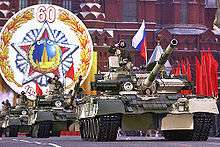 | ||
| T-72 | |
Main Battle Tank | 200+[30] | 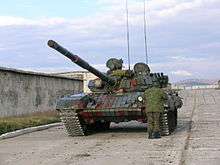 |
Some T-72B mod. 1989 are in service with Kontakt-5 ERA. Estimated 530-540 T-72 tanks are in service together with the Nagorno-Karabakh Defense Army.[31] Armenia also received 35 T-72s from Russia in 2013 [32] | |
| T-55 | |
Main Battle Tank | 8 | |
3 T-54 and 5 T-55 | |
| BMP-2 | |
Infantry fighting vehicle | 50 |  |
50 units modernized/repaired by Russia in 2012-2013[33] Possibly more in storage [34] | |
| BMP-1 | |
Infantry fighting vehicle | 75 | |
||
| BMP-1K | |
Infantry fighting vehicle | 7 | 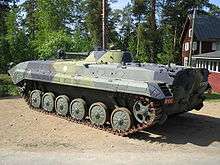 |
Command Variant | |
| BRM-1K | |
Infantry fighting vehicle | 12 | 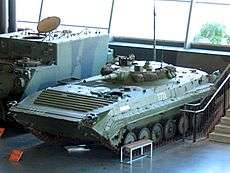 |
Command Variant | |
| BMD-1 | |
Infantry fighting vehicle | 10 |  |
||
| BRDM-2 | |
Scout car | 120 |  |
Includes anti-tank variant | |
| BTR-80 | |
Armoured personnel carrier | 110 |  |
Possibly more in storage.[32][34] Number does not include unknown number of Infauna electronic countermeasure variants first displayed at the 2016 military parade.[35] | |
| BTR-70 | |
Armoured personnel carrier | 40+ |  |
Upgraded with new engines and 30mm gun | |
| BTR-60 | |
Armoured personnel carrier | 100+ |  |
||
| BTR-152 | |
Armoured personnel carrier | |
|||
| MT-LB | |
Armoured personnel carrier | 145 | |
Including following variants:
| |
| GAZ-2975[36] | |
Armoured personnel carrier | 4 | |
More ordered in 2015[37] | |
Multiple Rocket Launchers
Military equipment Armenian Army as of 2008-2016
| Name | Origin | Type | Number | Photo | Notes | |
|---|---|---|---|---|---|---|
| Multiple Rocket Launchers | ||||||
| BM-30 Smerch | |
Multiple rocket launcher | At least 2 launchers | 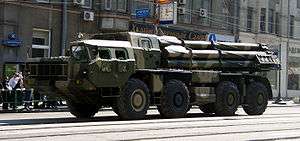 |
Displayed during 2016 Independence Day Parade[38] | |
| WM-80[39] | |
Multiple rocket launcher | 4-8 |  |
Purchased from China in 1999 | |
| BM-21 Grad | |
Multiple rocket launcher | 47 |  |
More in service with the Nagorno-Karabakh Defense Army | |
| N-2 | |
Multiple rocket launcher | At least 2 | 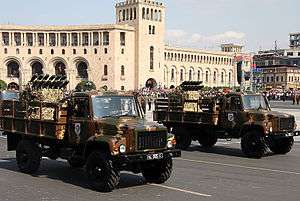 |
Locally produced | |
Self-propelled artillery
Military equipment Armenian Army as of 2008-2016
| Name | Origin | Type | Number | Photo | Notes | |
|---|---|---|---|---|---|---|
| Self-Propelled Artillery | ||||||
| 2S3 Akatsiya | |
Self-propelled artillery | 28 |  | ||
| 2S1 Gvozdika | |
Self-propelled artillery | 10 | 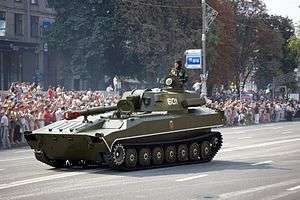 |
||
Military Engineering Vehicles
| Name | Type | Quantity | Photo | ||
|---|---|---|---|---|---|
| BAT-2 | | Combat engineering vehicle | 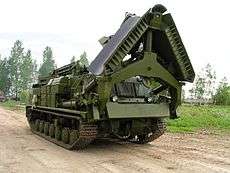 | ||
| MTU-72 MTU-90 | | Tracked armoured vehicle-launched bridge | 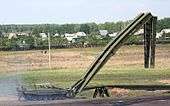 | ||
Field Artillery
Military equipment Armenian Army as of 2008-2016
| Name | Origin | Type | Number | Photo | Notes | |
|---|---|---|---|---|---|---|
| Field Artillery | ||||||
| D-30 | |
Howitzer | 69 | 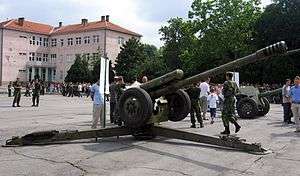 | ||
| D-20 | |
Howitzer | 34 |  | ||
| 152 mm gun 2A36 | |
Field Artillery | 26 | .jpg) | ||
| M-46[40] | |
Field Artillery | N/A |  | ||
| M-30[41] | |
Field Artillery | N/A |  |
With upgraded optics | |
| T-12 | |
Anti-tank gun | 36 | .jpg) |
||
Tactical Ballistic Missile Systems
Military equipment Armenian Army as of 2008-2016
| Name | Origin | Type | Number | Photo | Notes | |
|---|---|---|---|---|---|---|
| Ballistic Missiles | ||||||
| Iskander-M | |
short-range ballistic missile | 4 launchers | 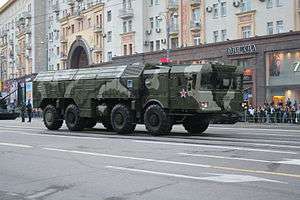 |
4 launchers, unknown number of missiles.First shown during the preparations for the 2016 military parade in Yerevan. [42] | |
| SCUD-B | |
short-range ballistic missile | 8 launchers | 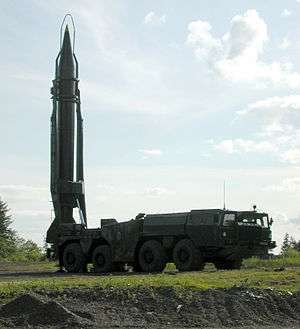 |
32 missiles[43][44] | |
| OTR-21 Tochka | |
short-range ballistic missile | 7-8 launchers [45] | 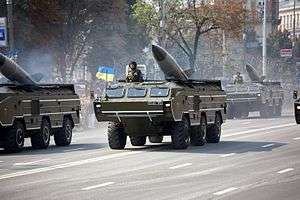 |
Unknown number of missiles | |
Anti-Aircraft
Military equipment Armenian Army as of 2008-2016
| Name | Origin | Type | Number | Photo | Notes | |
|---|---|---|---|---|---|---|
| Anti-Aircraft | ||||||
| S-300PM | |
surface-to-air missile | At least 8 launchers | 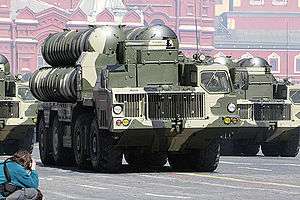 | ||
| S-300PT-1 | surface-to-air missile | 3 battalions positioned around Yerevan[46] | ||||
| 9K33 Osa | |
surface-to-air missile | 10 |  |
||
| BUK-M2 [47] | |
Surface-to-air missile | N/A |  |
First shown during the preparations for the 2016 military parade in Yerevan. | |
| 2K11 Krug | |
surface-to-air missile | 115 | 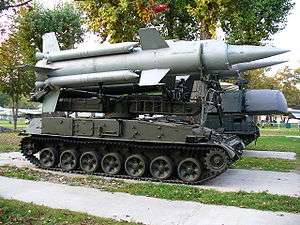 |
||
| 9K35M3 Strela-10M3 | | Short range SAM | 10 |  | Designated SA-13 "Gopher" by NATO. | |
| 2K12 Kub[48] | |
surface-to-air missile | N/A | 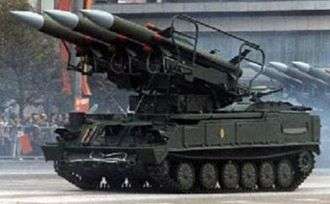 | ||
| S-75 Dvina | |
surface-to-air missile | 79 | 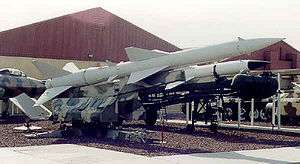 | ||
| S-125 Neva/Pechora | |
surface-to-air missile | N/A | 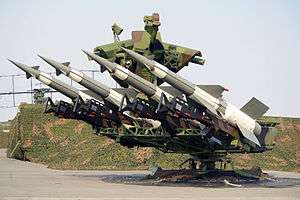 | ||
| ZSU-23-4 | |
SPAA | N/A | 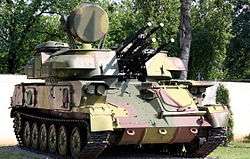 | ||
| ZU-23-2 | |
Anti-aircraft gun | N/A | 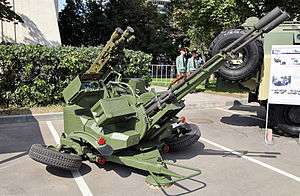 | ||
| 57 mm AZP S-6 | |
Anti-aircraft gun | N/A | 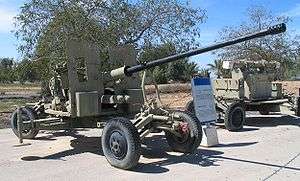 |
||
Radar Systems
Military equipment Armenian Army as of 2008-2016
| Name | Origin | Type | Number | Photo | Notes | |
|---|---|---|---|---|---|---|
| Radar Systems | ||||||
| P-12 radar | |
radar | N/A |  | ||
| P-15 radar | |
radar | N/A |  | ||
| P-40 radar | |
radar | N/A | 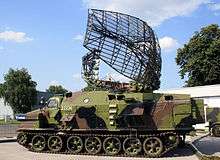 | ||
| Avtobaza[49][50] | |
radar | N/A | _(525-43).jpg) |
Part of Russian-Armenian arms deal | |
Future Equipment
Military equipment Armenian Army as of 2008-2016
| Name | Origin | Type | Number | Photo | Notes | |
|---|---|---|---|---|---|---|
| Future Equipment | ||||||
| TOS-1A | |
Multiple rocket launcher | N/A |  |
Part of Russian-Armenian arms deal. Will be delivered in 2016. [51][52][53] | |
Other
Body Armor
- Locally produced body armor in use with all military units
- Polish-Armenian company Lubawa SA is to begin supplying Armenian military units with Kevlar helmets and body armor, along with multi-spectral camouflage for vehicles.[54][55]
See also
Notes
- ↑ International Institute for Strategic Studies (IISS). The Military Balance 2013. London: Routledge, 2013, pp. 215-16.
- ↑ "Military Balance in Europe 2011"., March 07, 2011.
- ↑ Petrosyan, David. "Formation and Development of Armenian Armed Forces." Moscow Defence Brief. Centre for Analysis of Strategies and Technologies, Moscow, 6-2002, accessed November 2009. Ter-Grigoryants had previously served with the 40th Army (Soviet Union) in Afghanistan as chief of staff, supervising operations in May 1982.
- 1 2 Jane's World Armies. Coulsdon, Surrey, UK: Jane's Information Group, October 2004.
- 1 2 Ministry of Defense of the Republic of Armenia. General History of the Armenian Army. Retrieved January 31, 2006.
- ↑ Curtis, Glenn E. and Ronald G. Suny. "Armenia," in Armenia, Azerbaijan, and Georgia Country Studies, ed. Glenn E. Curtis. Washington D.C.: Federal Research Division Library of Congress, 1995, p. 72.
- ↑ Mirsky, Georgiy I. On Ruins of Empire: Ethnicity and Nationalism in the Former Soviet Union. Westport, CT: Greenwood Press, 1997, p. 63. ISBN 0-313-30044-5.
- ↑ See Richard Giragosian, "Armenia and Karabakh: One Nation, Two States." AGBU Magazine. № 1, Vol. 19, May 2009, pp. 12-13.
- ↑ Kosovo Force. KFOR Contingent: Armenia. KFOR. Last updated January 24, 2006. Accessed February 9, 2007.
- ↑ NATO’s relations with Armenia. NATO. Retrieved November 29, 2009.
- ↑ "Armenian peacekeeper to undergo two more surgeries." Public Radio of Armenia. November 20, 2006. Retrieved February 1, 2007.
- ↑ Glassey, Eric. "Armenians Complete Successful Mission." Multinational Force in Iraq. October 7, 2008. Accessed September 6, 2009.
- ↑ "Armenia to send forces to Afghanistan this year." Armenian Reporter. July 24, 2009. Retrieved September 6, 2009.
- ↑ "Armenia To Send Troops To Afghanistan." RFE/RL. November 09, 2009. Retrieved November 29, 2009.
- ↑ "Armenian Parliament Endorses Troop Deployment To Afghanistan." RFE/RL. December 8, 2009. Retrieved January 3, 2010.
- ↑ International Institute for Strategic Studies (IISS). The Military Balance 2012. London: Routledge, 2012, pp. 90-91.
- ↑ "Armenia and Lebanon Sign 2016 Military Cooperation Plan." Massis Post. November 27, 2015.
- 1 2 IISS (2007). The Military Balance 2007. London: Routledge for the IISS. p. 155. ISBN 978-1-85743-437-8.
- ↑ See Human Rights Watch/Helsinki Watch, Azerbaijan: Seven years of conflict in Nagorno-Karabakh, New York: Human Rights Watch, 1994, p. 69.
- ↑ "Reconnaissance Scouts on Karabakh Frontline Tight-Lipped About Themselves, Their Actions". Hetq.am. Retrieved 24 December 2014.
- ↑ "Bodies of Armenian pilots removed from helicopter crash site". Reuters. Retrieved 24 December 2014.
- ↑ https://www.youtube.com/watch?v=1GFWA63a0bE
- ↑ https://www.youtube.com/watch?v=1GFWA63a0bE
- ↑ "The Armed Forces of Armenia Official Thread - Page 126". Retrieved 24 December 2014.
- 1 2 3 4 5 6 Armyrecognition.com Armenia Land Forces military equipment and vehicles Armenian Army. August 2013.
- ↑ (Armenian) "Ադրբեջանական լրատվամիջոցներն անդրադառնում են ՄԻԼԱՆ-ի վերաբերյալ Ռազմինֆոյի հրապարակմանը."
- ↑ http://www.janes.com/article/58187/russia-details-usd200-million-arms-sale-to-armenia
- ↑ The Military Balance 2016. – Page 178
- ↑ Jane's World Armies. Coulsdon, Surrey, UK: Jane's Information Group, 2008.
- ↑ http://razm.info/18679
- ↑ http://razm.info/18679
- 1 2 (Russian) .
- ↑ (Russian) Центр анализа мировой торговли оружием. p. 17.
- 1 2 (Russian) .
- ↑ (Russian)Военный парад, посвященный 25-летию независимости Армении, прошел 21 сентября в Ереване
- ↑ (Armenian) "Մեր զորահանդեսից հետո Բաքուն հասկացավ, որ չի կարող լուծել Ղարաբաղի հարցը ռազմական ճանապարհով" [After Our Military Parade, Baku Understands that it Cannot Resolve the Karabakh Question through Military Means]. PanArmenian.net. October 14, 2011.
- ↑ http://www.janes.com/article/58187/russia-details-usd200-million-arms-sale-to-armenia
- ↑ https://www.youtube.com/watch?v=0Z7Q4nW5vkU&t=7m13s
- ↑ "New Chinese Rockets ‘Acquired By Armenia’." RFE/RL. August 19, 2013. Retrieved August 22, 2013
- ↑ https://www.youtube.com/watch?v=l5U4Kmun2WU#t=00m13s
- ↑ https://www.youtube.com/watch?v=0Lbct2tKRDs#t=01m56s
- ↑ http://www.panarmenian.net/eng/news/221119/
- ↑ Gary K. Bertsch (2000). Crossroads and conflict: security and foreign policy in the Caucasus and Central Asia. Routledge. p. 173. ISBN 0415922747.
- ↑
- ↑ https://www.youtube.com/watch?v=Hvpf7sFUFaA
- ↑ "Armenian Air Defenses "A Strategic Analysis"". Retrieved 2016-09-24.
- ↑ "Buk system spotted during Armenia's Independence Day parade rehearsal". PanARMENIAN.Net. Retrieved 2016-10-07.
- ↑ https://www.youtube.com/watch?v=Q8LvphYNFys&t=0m38s
- ↑ http://www.janes.com/article/58187/russia-details-usd200-million-arms-sale-to-armenia
- ↑ http://www.azatutyun.am/content/article/27726142.html
- ↑ http://www.janes.com/article/58187/russia-details-usd200-million-arms-sale-to-armenia
- ↑ http://www.azatutyun.am/content/article/27676881.html
- ↑ http://asbarez.com/150152/russian-armenian-arms-contracts-mostly-signed/
- ↑ "Lubawa Armenia S.A. – fruitful meeting with MORA representatives."
- ↑ http://www.lubawa.com.pl/index.php/en/aktualnosci-2/2014/1494-lubawa-armenia-s-a-fruitful-meeting-with-mora-representatives